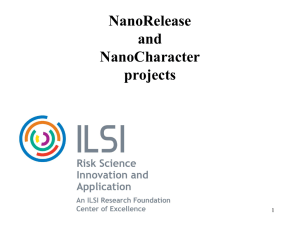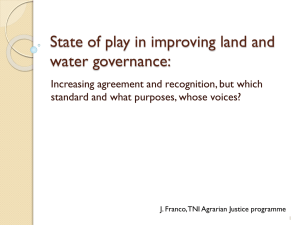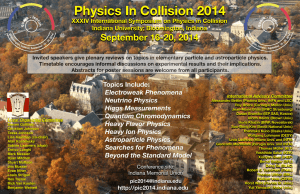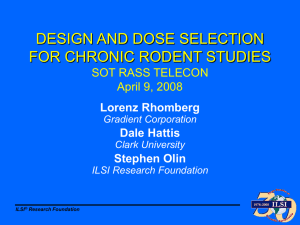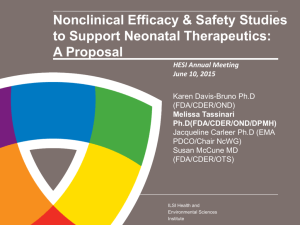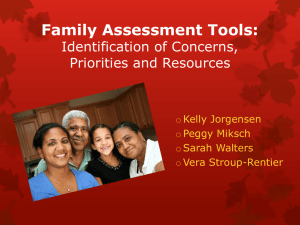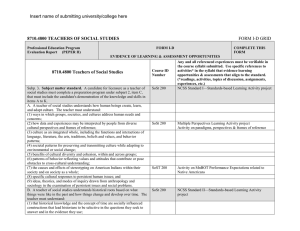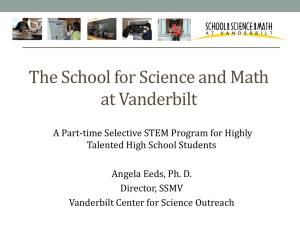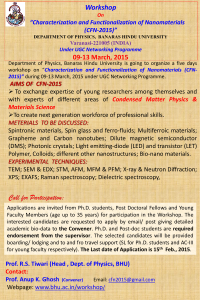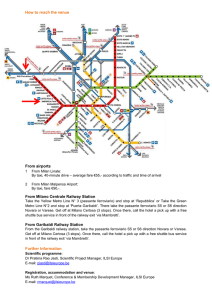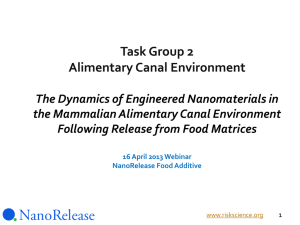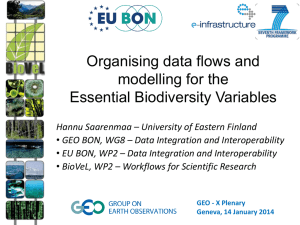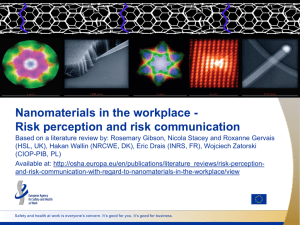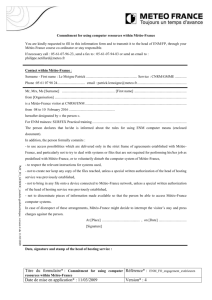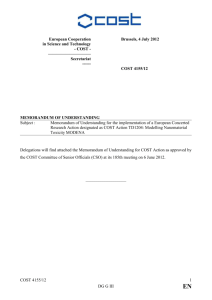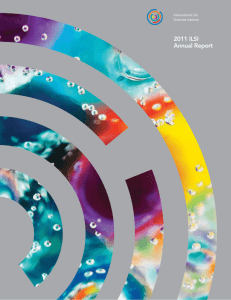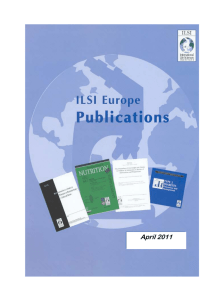NanoRelease Food Additive - International Life Sciences Institute
advertisement
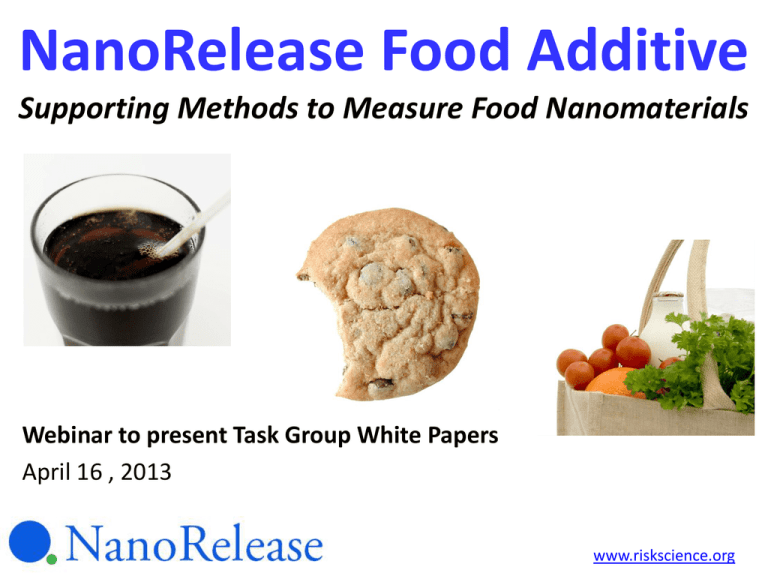
NanoRelease Food Additive Supporting Methods to Measure Food Nanomaterials Webinar to present Task Group White Papers April 16 , 2013 www.riskscience.org What is the issue being addressed? Nanopowder Dissolved constituents (no longer nano?) Engineered nanomaterials (ENM) used/being developed for food, beverages, supplements to: - increase nutrition - increase food safety (packaging, shelf life) - change physical/chemical properties Some “traditional” processed food components are nano too. Where do we focus the science to address potential risk? Methods to measure what nano characteristics affect absorption as nanoparticles into the body would greatly clarify where to focus attention. www.riskscience.org 2 About the project • 70+ multi-stakeholder experts collaborating for methods development for oral exposure to ENM • GOAL: Develop methods that distinguish which nanomaterials do and do not persist to absorption from food. thus provide data that help clarify risk thus allow safer, sustainable improvements OFFICIAL CHARGE: “Identify, evaluate, and develop methods needed to confidently detect, characterize and evaluate intentionally produced nanoparticles released from food along the alimentary tract, as occurring through direct food additives or indirect incorporation in food through migration from food contact materials or environmental contamination.” www.riskscience.org 3 Benefits of the project • Continuous technical dialogue internationally across key stakeholder experts about safe development of food nanotech • Public-private partnership allows balance of views from academia, industry, government, public interest organizations • Secretariat (ILSI Research Foundation) facilitates collaboration without backing any particular stakeholder view. www.riskscience.org 4 Organization within project TG1 Material Characteristics Develop charges and decide scope (e.g., what methods to improve) Steering Committee (SC) Collect and analyze information relevant to methods development TG2 Alimentary Canal Environment TG3 Alimentary Canal Models TG4 Measurement Methods TG5 Risk Management Aspects Top level view of the state of the science and context. State of the Science Team (SOST) Develop and implement workplans to improve methods. Interlaboratory Testing Group (ITG) www.riskscience.org 5 Steering Committee • COCHAIR Annette McCarthy (US FDA) • COCHAIR Steve Roberts (Univ. of Florida) • Timothy Duncan, Scott Thurmond, Gregory Noonan (FDA) • Thomas Neltner (Pew Charitable Trusts) • Andrew Maynard (Univ. of Michigan) • Joseph Scimeca (Cargill, ILSI NA) • David Carlander (Nanotechnology Industries Association) • Francois Rossi (European Commission) • Stephane Vidry, Alessandro Chiodini (ILSI Europe) • Danielle Fugere (As You Sow) • Robert Brackett (Institute for Food Safety & Health) • Shaun Clancy (Evonik Degussa) • Carolyn Cairns, Michael Hansen (Consumers Union) • Neil Buck (DSM, ILSI Europe) • Stefan Weigel (RIKILT – Institute of Food Safety) • Abdul Afghan, Don Forsyth, Andrew Atkinson, David Lefebvre, Mark Perry, Rekha Mehta (Health Canada) • Rickey Yada (Univ of Guelph) • Vicki Stone (Heriot Watt Univ.) • Eva Maria Collnot (Saarland Univ.) • John Milner (USDA) • Susann Bellman (TNO Netherlands) www.riskscience.org 6 Jan-May 2012 SC gathered, establishes goal, scope, & focuses of TGs June-Sept 2012 TGs gathered, finalize charges, collect and evaluate info Sept 2012 - Now TGs draft and finalize white papers. SOST gathered, follows TG progress & drafts review article Mid 2013 TGs & SOST submit for publication, ITG & SC review information and decide on workplan(s) 2013-2014 Methods development (interlaboratory round robin) TIMELINE Sept 2012 PROJECT WEBINAR Dec 2012 WORKSHOP Washington, DC Jan 2013 SOST MEETING Miami, FL April 2013 PROJECT WEBINAR 7 SOST State of the Science Team is an experienced, balanced multistakeholder set of experts who are writing a “state of the science” report on: What do we know and need to know to measure and understand the likelihood of nanomaterial uptake by the body? Andrew Bartholomaeus Christopher Szakal U. of Canberra & U. of Queensland US National Inst. of Standards & Technology Ian Illuminato Friends of Earth John Milner Human Nutrition Research Ctr. (USDA) Michael Rogers Rutgers University Neil Buck DSM Nutritional Products Paul Westerhoff Arizona State University Steve Roberts University of Florida Andrew Cockburn (peer review) University of Newcastle Paul Howard (peer review) US Food and Drug Admin. ITG INTERLABORATORY TESTING GROUP • Lab research experts currently being gathered • OBJECTIVE: Develop or investigate standardization of existing methodologies (adaptation and validation) with any necessary modifications • Interlaboratory work plans will improve/develop methods for understanding uptake, using (-) and (+) controls and selected ENM in modeled GI conditions • ULTIMATE GOAL: promote standardization or scientific consensus on practical methods for evaluating potential uptake of ENM from alimentary canal www.riskscience.org 9 Goal for this webinar • Present high point findings of the task groups • Inform the State of the Science team as they prepare their summary • Seek input from stakeholders • Inform the Steering Committee as they select methods to carry forward www.riskscience.org 10 Suggested topics for feedback Please note that the project goal is to GOAL: Develop methods that distinguish which nanomaterials do and do not persist to absorption from food. thus provide data that help clarify risk thus allow safer, sustainable improvements For example, please help us inform the Steering Committee in their task to - Cover what needs to be covered to prepare to address this goal - Narrow scope to practical and near-term methods improvement - Select methods improvements to address - Identify how to improve the methods - Identify synergies and partnerships Thank you Richard Canady, PhD Libby Tsytsikova, BS Secretariat for nanorelease@ilsi.org Center for Risk Science Innovation and Application (RSIA) ILSI Research Foundation 1156 Fifteenth ST. NW, Suite 200 Washington DC 20005-1743 Tel: +1-202-659-3306 ext153 www.riskscience.org 12

